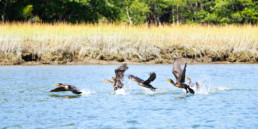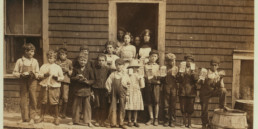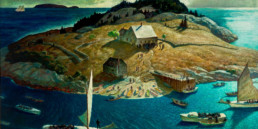Image courtesy of the Universal History Archive
When the Irish Invaded Canada
Fenian Brotherhood, with members from Vinalhaven, planned to seize Campobello
by Christopher Klein
Less than a year after Robert E. Lee relinquished his sword at Appomattox Court House, a band of battle-hungry Mainers boarded a steamship in Portland. Armed with revolvers and Bowie knives, the volunteer soldiers had no intentions of traveling south to reignite the Civil War. Instead, the Irish immigrants sailed Downeast on a most fantastical mission to use the islands of Passamaquoddy Bay as steppingstones to liberate their homeland an ocean away.
To the Irish revolutionaries who departed Casco Bay in the first week of April 1866, glimpses of the Atlantic surf pounding Maine’s untamed coastline stirred warm memories of the Emerald Isle, which had been Great Britain’s unwilling colony for seven centuries. In a quest to recast the Irish in their own image, the British attempted to extinguish Ireland’s culture, language, and religion, and when the island’s potato crop failed in 1845, some Irish thought the British were trying to exterminate them altogether.
The Great Hunger claimed approximately one million lives and forced another two million Irish to abandon the island. Refugees who settled in Maine found work in the lumber mills of Bangor, the textile factories of Lewiston, the shipyards of Portland, and the quarries around Penobscot Bay. Forever scarred by the horrors of the Great Hunger, many of these exiles would always consider themselves Irish first, American second.
The most militant of these Irish Americans enlisted in the Fenian Brotherhood, a revolutionary organization founded in 1858 by John O’Mahony, a leader of the failed 1848 Young Ireland rebellion. Using the proceeds of war bonds that would be payable with 6% interest six months after the establishment of the Irish Republic, O’Mahony’s group purchased weapons that it planned to ship to its sister organization, the Irish Republican Brotherhood, to wield against the British in Ireland.
As the Civil War drew to a close, the Irish who cut and carved stones on the Fox Islands formed Maine’s first Fenian chapter in Vinalhaven. In the days following Abraham Lincoln’s assassination, Fenian recruiter and future Boston mayor Patrick A. Collins whistle-stopped through Maine and formed new chapters in Bath, Augusta, Bangor, Lewiston, Portland, Waterville, and Biddeford.
Along with the Fenian Brotherhood’s exponential growth, however, came a widening schism. While O’Mahony wished to stay true to the original, long-term objective of attacking British forces in Ireland, a breakaway group led by William Roberts sought more immediate action by striking the British Empire at its nearest point—the colony of Canada.
Few Irishmen in New York City had a less enjoyable St. Patrick’s Day in 1866 than O’Mahony. As Irish revelers paraded through the streets, he grappled with his soul inside a Manhattan brownstone that served as Fenian headquarters. With his faction losing headlines and donations to the Roberts wing, O’Mahony felt the organization he had carefully nurtured slipping from his grasp.
Although only a week earlier he had proclaimed that “the men who propose to invade Canada have no right to call themselves Fenians,” an anguished O’Mahony reluctantly changed course and approved a plan to seize Campobello Island, which sat in Canadian waters across a narrow channel from the far eastern corner of Maine. The plot was the brainchild of Fenian treasury secretary Bernard Doran Killian, who asserted that a quick strike would pre-empt the northern invasion planned by Roberts and allow O’Mahony to regain his place at the vanguard of the revolutionary movement.
The Irish-born Killian argued that the Fenians could use Campobello Island, which provided sanctuary for British loyalists and traitor Benedict Arnold’s vast smuggling enterprise after the American Revolution, as a base from which to launch an invasion of Ireland and gain belligerent status to legally issue letters of marquee to privateers who could disrupt British sea trade.
In Killian’s wildest dreams, the attack could spark an Anglo-American war as the U.S. looked northward to fulfill its Manifest Destiny.
O’Mahony put his treasury secretary in charge of the expedition, although he had no experience in commanding an army. Before sailing to Maine separately, Killian supervised the loading of the Fenian arsenal onto a barely seaworthy vessel that belonged to the Confederacy before the Irishmen bought it at auction from the U.S. Customs Service.
On April 6, “General” Killian and the first wave of Fenian soldiers disembarked in Eastport, the nearest American city to Ireland, with plans to strike Campobello Island the following day. The plan’s mastermind discovered to his disappointment, however, that the craft with the Fenian weapons hadn’t arrived—but British defenses had.
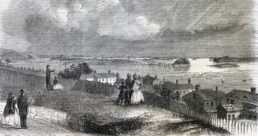
Bystanders watch as British naval units arrive in Eastport Bay, the scene of the Fenian Demonstration. Sketch by A.C. Warren / Courtesy of Dickinson College
“No news travels so freely or so fast as the ‘secret’ doings of the Fenian Brotherhood,” quipped Mark Twain. “In solemn whisperings in the dead of night they secretly plan a Canadian raid, and publish it in the World next morning.” Indeed, the New York World and rival newspapers had printed every detail of the Fenian deployment to Maine.
Within days of O’Mahony’s approval of the Campobello venture, British authorities knew all about it since the Fenian leader’s close confidant, James McDermott, was selling secrets to the British consul in New York. When O’Mahony learned that the campaign’s secrecy had been compromised, he ordered the Fenian ship with Killian’s guns to return to New York and stopped several hundred Boston Fenians from traveling to the border.
Forced to postpone the attack until a rented schooner arrived from Portland with other Fenian muskets, Killian spent several awkward days lodging in the same hotel as British detectives and a U.S. marshal. Amid the delay, two British warships and thousands of British and New Brunswick troops arrived in Passamaquoddy Bay.
Tired of dawdling their days away, one group of restless Fenians decided to finally breach the border. Near midnight on April 14, nine Irishmen lowered in a boat from a Fenian privateer and rowed with muffled oars right beneath the nose of the HMS Pylades.
After landing on Indian Island, sandwiched between Eastport and Campobello Island, the Fenians rapped on the door of the British customs house and demanded possession of the Union Jack flying over it, which the deputy customs collector readily surrendered. Satisfied with their war trophy, the Fenians departed the island in triumph without causing any damage or firing a single shot.
Days after the midnight game of “capture the flag,” the Fenian schooner from Portland finally arrived, but the 129 cases of arms aboard were seized by American forces now led by Major General George Meade, who had been dispatched to Eastport by Secretary of War Edwin Stanton and Lieutenant-General Ulysses S. Grant to enforce American neutrality laws.
In a last-ditch effort to convince Meade to release custody of the guns, Killian told one heck of a fish tale. He claimed the hundreds of Irishmen loitering around Eastport were on a fishing excursion and needed the muskets and carbines to protect themselves against over-aggressive Canadian anglers. Meade didn’t bite. Devoid of weapons and money, Killian abandoned his post and sailed home to New York.
Although their general had departed, the Fenians remaining in Eastport did not give up the fight. Under the cover of darkness on April 20, a raiding party again landed on Indian Island. This time they torched four buildings, including a British customs warehouse. Ironically, the attack inflicted the most damage on fellow Americans as the Fenian inferno consumed two stores owned by a pair of Eastport residents.
Two nights later, dozens of Fenians hijacked a schooner and directed the captain to set sail for Campobello Island. Although they didn’t elicit a response from an artillery company from South Portland’s Fort Preble encamped on Treat Island, the Irishmen roused the attention of British warships that forced a hasty retreat to American soil.
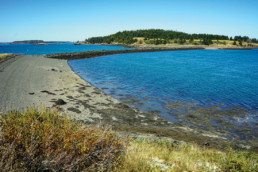
Treat Island, looking north from Dudley Island with Eastport in the distance. Treat Island is adjacent to Campobello Island and the Canadian border. PHOTO: Tom Groening
With Passamaquoddy Bay locked down by both American and British forces, the discouraged Fenians followed Killian’s lead and returned home. The venture dubbed the “Eastport fizzle” by critics cost the Fenian Brotherhood $26,000 and O’Mahony his leadership post. The Fenian founder had contradicted his long-held belief and had nothing to show for it except ridicule—and one captured Union Jack.
While the Downeast fiasco was worthy of a comic opera, an invasion of Ontario by the Roberts wing weeks later turned deadly serious as more than a dozen men perished when the Fenians defeated Canadian defense forces at the Battle of Ridgeway. The triumph proved short-lived, however, as the Fenians were forced to retreat when American forces cut their supply lines.
In a strange twist of history, the Eastport expedition indeed helped to bring self-government to a British colony—just not the one the Irishmen intended. The Fenian menace on the southern border highlighted the benefits of a confederation of Canadian provinces for the region’s self-defense, and previously controversial pro-confederation measures passed decisively in both New Brunswick and Nova Scotia in the weeks following the Fenian foray. A little more than a year later, the first Canadian parliament convened in Ottawa, thanks in part to the Irish shenanigans in Passamaquoddy Bay.
Christopher Klein is the author of four books, including When the Irish Invaded Canada: The Incredible True Story of the Civil War Veterans Who Fought for Ireland’s Freedom and The Boston Harbor Islands: Discovering the City’s Hidden Shores. His history stories have appeared in the Boston Globe, the New York Times, and History.com, the website of the History Channel. Learn more at www.christopherklein.com.



